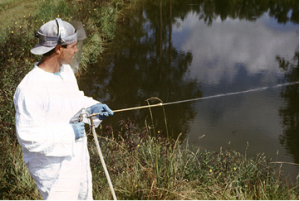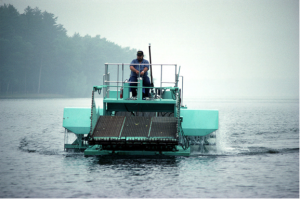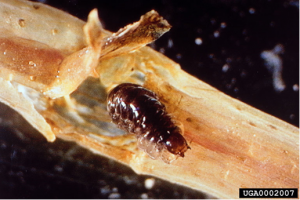A licensed applicator treats a lake with aquatic herbicides in Florida
Chemical control is the use of man made chemical compounds to manage the population of an invasive aquatic plant. These compounds are known as aquatic herbicides. In order to come to market all pesticides, including aquatic herbicides, must go through rigorous testing and research by the manufacturer before being approved for use by the Environmental Protection Agency. Pesticides are packaged and sold to consumers with legally binding instructions called a pesticide label, and must be applied by or under the supervision of a certified applicator, in Maine they must be certified by the Maine Pesticide Control Board. Failure to follow the directions on the label or to apply pesticides without certification is a federal offense. In Maine the use of aquatic herbicides is tightly regulated by the Department of Environmental Protection. Permitting is required. So far there has been limited use of aquatic herbicides, reserved for the most dire of situations. Pickerel Pond in Limerick has been treated for hydrilla with a mixed degree of success.
There are four major classes of aquatic herbicides: contact, systemic, selective and non-selective. Contact herbicides kill the part of the plant that they come into contact with, meaning that they may or may not damage the interior tissue. They are fast acting but fairly non-selective. The effect of use on woody plants is generally defoliation and new growth may occur. Use on herbaceous plants, which includes most aquatic plants, generally results in a more complete kill of annuals, but re-growth can occur on plant parts not targeted. If the shoot is contacted, the roots may remain alive and retain the ability to grow and reproduce. Systemic herbicides cause death of the entire plant, as they are absorbed and move through tissues. Their effect takes place at a slower rate, but they are generally more effective than contact herbicides. Contact and systemic herbicides can then be classified with the following selectivity: Selective herbicides only affect specific types of plants, whereas non-selective herbicides affect all plants they contact. Some Pesticides also contain an adjuvant, nontoxic compounds in a pesticide mixture that increase the effects of the toxic compounds. New Hampshire has recently used herbicides to control variable leaf milfoil. To learn more about their efforts, visit The New Hampshire Department of Environmental Services Herbicide Control for Milfoil Fact Sheet
Mechanical control is the use of machines, called harvesters, in direct contact with the plant to reduce or remove an invasive plant infestation. Harvesters may cut plants near the surface or reach to the base of the plant depending on the plant manager's goals.
Often mechanized harvesters will be equipped with a conveyer to remove the cut plant material from the water body. Doing so reduces the amount of plant material left in the system and therefore decreases regrowth from fragmentation. Reming of the cut plants immediately opens the water to recreation and improves the aesthetics of the water body. Ecologically, the cut and remove practice of mechanical harvesters has its upsides as well. The material is removed and decomposes out of the water rather than in it. Bacteria and invertebrates that would consume the dead plant tissue do not deplete the oxygen of the system.
A mechanized harvester is used to clear invasive plants in Wisconsin
While most plant fragments are removed some are left in the system. Many invasive aquatic plants are able to spread by fragmentation and some invasive populations benefit on the long term from mechanical harvesting. Selectivity is an issue as well; native plants growing in and around infestations of exotic plants are equally subject to harvest. Of course, depending on the severity of the infestation, this may not be of concern.
Cost and time are major constraints for this type of removal. A mechanized harvester is usually contracted out for between five hundred and eight hundred dollars a day, and many models cost up to two hundred and fifty thousand dollars to purchase. A harvester is capable of clearing between one and three acres of plants each day, but does not kill the plants. They will grow back resulting in the need for repeat treatments. Multiple treatments tactfully carried out will deplete the plants energy reserves and eventually may reduce the infesting population.
Biological control is the use of an invasive plant's natural enemies to control their population. The agents used are typically native to the same regions as the problematic invasive. The biological control agents’ populations are monitored and can be augmented in continual releases. The agents may include insects, such as the milfoil weevil, Euhrychiopsis lecontei, which disrupts the plants transport of sugar, grazing vertebrates like the grass carp, Ctenopharyngodon idella, or mycoherbicides, which are fungi applied similarly to herbicides.
Euhrychiopsis lecontei, the milfoil weevil (here in larval form), feeding on eurasian milfoil.
The most common type of biological control is the use of plant-eating, insects like the milfoil weevil. But animals of many types have been used globally. There has been a release of three hundred and fifty species worldwide to combat invasive weeds. It is important to note that of these programs only seventeen percent have been deemed successful. In order for a biological control program to be a success, there must have been a clear and measurable decrease in the target invasive’s population, with no sign of the control agent becoming a problematic species itself.
As with many control options, time and money are an issue with biological control. It may take ten or more years of research to determine if a potential control agent is viable for use without presenting an invasion problem of its own. All of this research and development coupled with execution of the program (stocking, and management) typically costs in the $3 million-$8 million range for the initial program.